 |
|
 |
|
|
Home →
Publications →
In the News
|
|
|
|
Secrets to Survival
Backpacker Magazine - October 1992
Larry Rice
|
|
|
|
Front Cover |
|
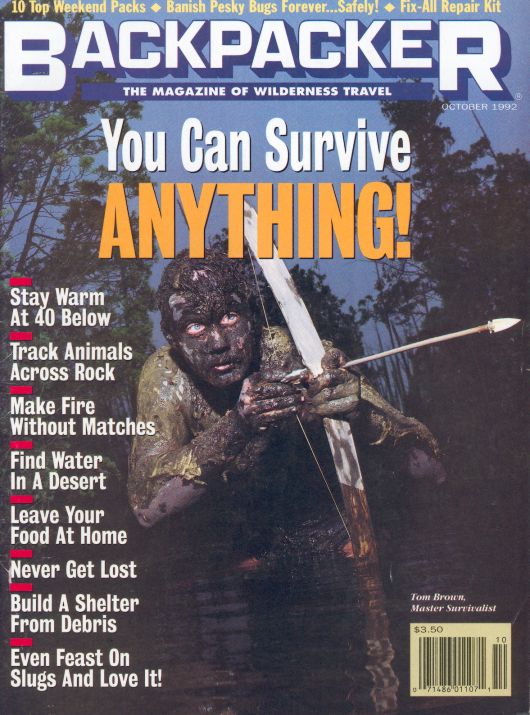
|
|
|
|
Table of Contents Page |
|
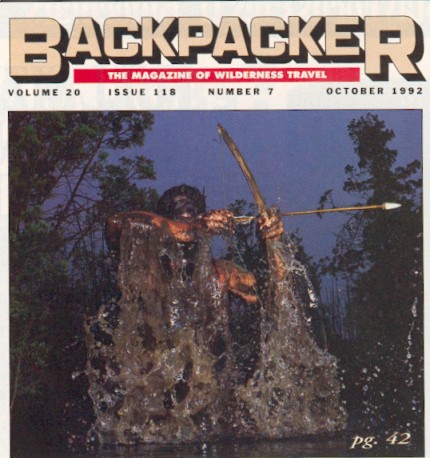
|
|
|
|
In the world according to Tom Brown,
everything you need to stay alive is in the wilderness. |
|
|
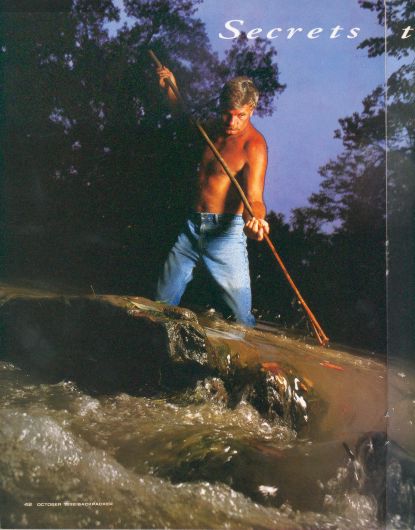 |
Tom Brown fishes with a handmade spear in a
tributary of the North branch River, New Jersey. He says the
primitive technique, which mimics the slow, deliberate movements
of a hungry heron, is "easier than line fishing." |
|
|
|
|
The teacher's first words to his attentive pupils stiffened
every spine in the old barn-turned classroom: "It's going to be one
helluva grueling week, I kid you not. I don't believe in free time when
you're on a course like this. I'm not some gray-haired old guru, and we
don't sit and jabber under an old oak tree."
The speaker is Tom Brown Jr, the infamous
"Tracker," operator of the nation's largest wilderness survival
school, and author of a best-selling library of field guides built around
his experiences and knowledge of staying alive in the outdoors. (The
Tracker was his first and probably most widely read book.) Perched on
too-hard wooden benches, listening intently, are 43 students, ages 15 to
65, from all over the United States. We are computer programmers, business
executives, park rangers, mountain guides, college students, artists and
aspiring actresses, and we have gathered at Brown's rural dairy farm in
Warren County, New Jersey for one purpose: to learn to survive in the
wilderness using only our wits and what nature provides.
Pacing back and forth with restrained energy, Brown, 41, is
intense. His clear blue eyes stare straight ahead, wilting subjects of
lesser fortitude. He's 6'2", 200 pounds and moves with the grace of a
Tai-Chi master. This is the man who teaches Navy Seals escape and evasion
tactics, who has been shot four times during law enforcement searches, and
has pulled more than 160 bodies out of the woods -- most of them dead from
lack of survival skills, and the others just plain criminals. A forceful
speaker and inspired teacher, Brown is impassioned and unequivocally sure
of himself. |
|
|
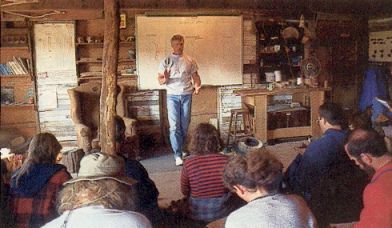 |
Much of the Tracker's beginner course
involves classroom lecture. Once equipped with the knowledge of
survival basics, students head out to the Pine Barrens to
practice the skills. |
|
|
|
|
All first-timers to the Tracker School complete the
beginner's course before tackling the more technical, physically demanding
advanced classes. In the coming days, we neophytes will learn nature
observation, tracking, survival, and Native American lifestyles and
philosophies. Brown says by week's end we'll be able to survive in the
wilderness without any traditional backpacking equipment, know more about
nature than we ever thought possible, and be able to track a mouse across
a cement floor. For the skeptics in the class, Brown backs up his claim
with a money-back guarantee, adding, "I've never had to refund any
money yet."
It's not that I question Brown's wisdom and abilities,
because to do so would be premature and narrow minded. Besides, who wants
to piss this guy off? But some of the things Brown says during the seven
days are incredible (read: hard to believe). Then again, it's fair to say
that Brown's life has been incredible (read: hard to believe), almost like
a Hollywood screenplay. So much so that he has been approached by movie
bigwigs and television producers.
Toms River, New Jersey, may seem an improbable locale to
learn the art of tracking and survival, but it was here, when Brown was
seven years old; that he fell under the influence of his best friend's
grandfather, an 83-year-old Apache medicine man named Stalking Wolf. For
10 years Stalking Wolf acted as the boys' mentor, teaching them the ways
of the Apache, as well as his own wilderness survival skills. Every day
after school and on weekends, the boys accompanied Grandfather, as they
called him, along the maze of sand trails threading through the swamps and
scrub trees known as the New Jersey Pine Barrens. These were no ordinary
camping trips, no Boy Scout outings. They were serious, often difficult
lessons involving survival, tracking, nature awareness, and ancient
philosophies of the Earth. "Apache scouts were superb
survivalists," Brown says, staring out the open window into a
corn-stubble field farmed by his neighbor. "They were mobile, their
awareness was second to none, they were legendary trackers, and
Grandfather was one of the best."
Initially, communication between Brown and
Grandfather was labored. There were differences in language (Grandfather
spoke little English) as well as culture, but slowly the gaps were
spanned. Brown became obsessed with learning the old ways.
"Grandfather was a 'coyote
teacher'," Brown explains, pausing briefly as several students change
cassettes in tape-recorders placed on the wooden platform up front.
"A coyote teacher would never answer your questions
directly. He would ask you another question or point you in a direction.
For example, when I asked Grandfather how to track, he said, 'Go ask the
mice'."
And that's what Brown did. For six months, whenever he had a
spare moment, Brown examined the minute tracks and droppings of voles,
mouse-like rodents common to the Pine Barrens. "My knees were
callused like the soles of old shoes from so much crawling around, but it
was a great education. Studying voles, doing dirt time on my belly, taught
me more about nature and tracking than all of the field books combined.
That's coyote teaching."
When Stalking Wolf died in 1970, Brown's apprenticeship ended
and his journeyman phase began. By this time, Brown admits he was a
"social misfit," preferring the company of animals to people,
and wilderness to civilization. He headed for the woods and the mountains
-- Yosemite, Death Valley, the Grand Canyon, Montana's Bob Marshall
Wilderness. His travels lasted nearly 10 years, during which time he used
no industrially-manufactured tool or product, preferring instead to live
off the land, honing his skills as a tracker, following Stalking Wolf's
teachings.
Brown was frightened when he walked out of
the wilderness in the late 1970s and returned to New Jersey. "Things
scared me about our Earth, primarily people's lack of spirituality and
awareness. They felt nothing, saw nothing, walked around like zombies. We
are a society of robots, our lives geared by clocks." Searching for a
niche was a daunting task for Brown. Friends and family asked why he
wasn't in college, why he didn't have a 9-to-5 job, why he wasted so much
time running around the Pine Barrens. |
|
|
|
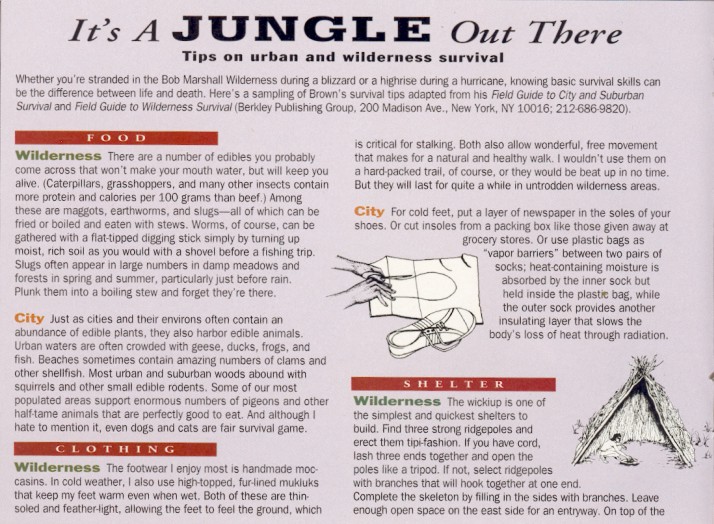
|
|
|
|
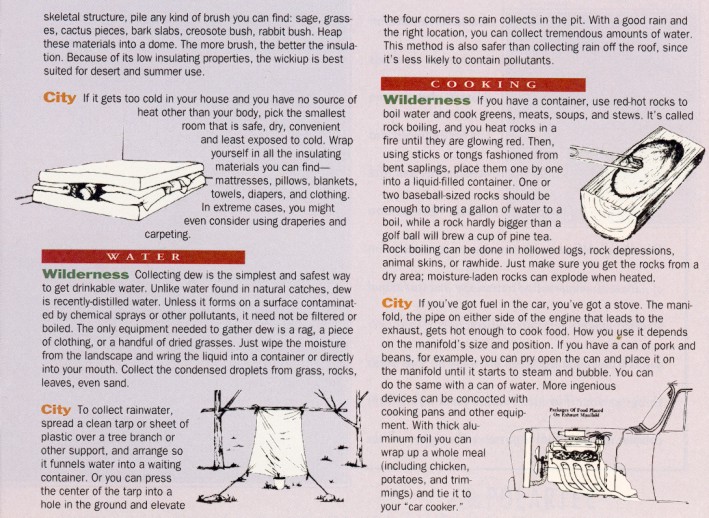
|
|
|
|
Brown's reputation as a tracker caught the attention of law
enforcement and rescue agencies. At first, police were skeptical, but in
nearly every instance, Brown says without modesty, he found his quarry
when hundreds of searchers, and even helicopters and dogs, could not. By
the age of 28, he'd found 40 missing persons and helped investigate four
murders. Minor celebrity status followed. Tom Brokaw interviewed him on
"The Today Show," and he was featured in People magazine. In
1978 a book about Brown's youth, The Tracker, was published and a
condensed version appeared in Reader's Digest, with a blurb at the end of
the article stating Brown was in the Pine Barrens teaching survival
skills. In truth, he was merely hanging out with friends. As a result of
the article, a truckload of mail was waiting when he returned home, all
from people wanting information about his survival school-the one that
didn't exist.
Leery at first about putting down roots, let alone
establishing a business, it took serious soul-searching before he realized
that teaching people how to stay alive in the outdoors was the answer to
what he was looking for in life. By 1980, Brown was traveling coast to
coast teaching classes and three- and four-day seminars. The Tracker had
become incorporated.
Like anything new and unproven, Tracker, Inc. went through a
period of trial and error. Brown initially took students into the Pine
Barrens with only the clothes they were wearing and a knife. "All
they learned was how to suffer for two weeks," he candidly admits.
"They spent all their time foraging and keeping warm - a waste of
time."
This is the reason his beginner course (booked up to a year
in advance) is half lecture and half skills. "You need the basics
before you can master the skills. You can't go into the wilderness
unarmed. Then, in the advanced courses, we take you through the transition
from regular camping to full survival living. That's when you understand
that pain and survival are not synonymous."
According to Brandt Root, a New York City stock trader who
completed several of Brown's advanced courses, making it through the
Tracker's "life and death situations" and learning things like
"how to make a fire in 30 seconds" builds confidence. "I
can make the transition from city to wilderness without any equipment. I'm
planning a fishing trip to Montana or Wyoming and the only thing I'm going
to take is my fly rod. If the world came to an end tomorrow, I could
survive longer than most."
Many of his students are urban dwellers who are proud of
their survival knowledge, but can rarely practice their skills because of
family and career responsibilities. Brown is the same way. When someone in
our class asks when he last went into the wilderness alone, he wearily
replies, "Years ago. The Tom Brown in The Tracker is dead."
There is silence in the room as he lights another Marlboro, ignoring his
rule that smoking isn't permitted inside. "I don't want to be here. I
want to be in the mountains more than anything. I can taste it. But I
can't live my dream, I have to live my vision. The only thing I can do now
is teach and write. I am a very, very desperate man." |
|
|
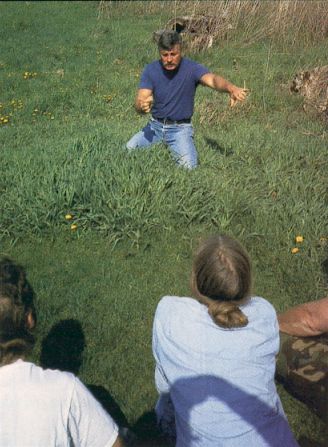 |
Brown demonstrates vole-tracking. He learned
how to track by spending hours of "dirt time" with the tiny
rodents, and he instructs his students to do the same. |
|
|
|
|
And here is where contradictions surface. He
teaches people how to live alone in the wilderness with nothing, but he
and his family live in a comfortable farmhouse complete with electricity,
running water, a VCR, even a home computer. When he goes to New York City
to meet with his publisher, Berkley Books, or his agent, he spends his
spare time tracking animals through Central Park. Although Brown longs to
be a wild man, he has a family to support, a business to run, books to
write, and a greater good to accomplish: "Earth Mother is running out
of time, but we can turn things around. That's the underlying reason I
have you here -- not so much to teach the skills, though they are the
doorsteps to the Earth, but to implore you to save the Earth. We have to
re-educate people to get back to the Earth, otherwise we are on borrowed
time."
For the better part of two days, both indoors
and in the field, Brown and his staff inundate our minds and notebooks
with the ancient art of tracking. "Tracks house a wealth of
information that escapes most people," Brown explains. "It's
like reading a topographic map. Everything going on in the animal's mind
and body is recorded in its track. Tracking is a window to the past --
looking into an animal's very soul."
While the beginners rarely get to see Brown's
legendary talents in action (no mouse tracking across cement), students of
the advanced classes have witnessed some amazing feats. During an advanced
tracking course, Brown spotted a coyote track 150 yards away. On that same
outing deep in the Pine Barrens, he casually pointed out raccoon tracks on
a tree 30 feet away.
We beginners are taught to mimic different
types of animal locomotion. To a casual onlooker, we are a bunch of
ridiculous adults hopping like rabbits, pacing like bears, and bounding
like weasels, all of which helps us grasp why animals leave a
characteristic track pattern. Next, we gather in an overgrown pasture,
where the remainder of the afternoon is spent belly-down in the grass
looking for vole scat and hair, and peering into tiny tunnel-shaped rodent
runways.
Although tracking with the Tracker is
intriguing, the big draw for many of Brown's students is learning how to
survive the "what if" situation. What if I get lost in the
woods? What if I capsize my canoe and I lose all my supplies? "When
you leave this school you won't have that nagging question," Brown
says at the start of his survival lecture. "You'll carry that
backpack into the wilderness, but you will not need it."
For the New York City stock trader, Brown's
teachings have indeed proven useful in the back country. "One time a
friend and I were canoeing. We were really out there when I realized we'd
forgotten the tent. I just fixed up a debris hut for two and it worked
fine. When you're not worried about things like getting lost or leaving
your tent, you enjoy the wilderness much more." Which is why Brown
stresses that the most important survival tool sits on your neck.
"Your mental attitude, your mind, will make or break you -- it's all
a matter of choice. If you're freezing, don't ask why you're cold. Ask
what can you do to get warm?"
Wilderness survival depends on maintaining
priorities, the most important being shelter, since most deaths are from
exposure to heat and/or cold. According to Brown, there's just one
approved shelter: the debris hut, an envelope-like nest of brush, leaves,
grass, and, that's right, debris that holds one person, maybe two. It's
the perfect natural sleeping chamber because it traps and holds heat,
which is probably why it's so popular with primitive cultures. On advanced
courses, students wearing little or no clothes have field-tested debris
huts in temperatures of -40°F, and have reported being too warm.
We learn how to gather water (the common grapevine, when
sliced, is a veritable garden hose); make arrows, and start a fire with a
bow and drill (I'll never take my Bic for granted again). Fifteen-hour
work days are the rule, not the exception. The most enjoyable session,
simply because it's the most relaxed, is imitating Euell Gibbons and
foraging for edible wild plants.
Brown dismisses the moral concerns raised by vegetarians when
we move on to hunting and trapping. "In full survival conditions,
especially in winter, you cannot survive on plants alone. You must hunt
and trap. Anything finned, furred, feathered or scaled is fair game."
We fashion sinister-looking snares and deadfalls, and practice throwing a
baton-like "rabbit stick," Brown's weapon of choice in a
survival situation.
But to kill a deer, or any animal, with a stick, you have to
be within striking distance, and that's where stalking comes in.
"Native Americans were close-range hunters. The mark of a good hunter
was how close he could get." To stalk means to move very slowly.
Grandfather taught Brown how to stalk by having him "fox walk"
barefoot on sharp stones. "With the fox walk," Brown
demonstrates, "you no longer move your head. You move from your
center. Your toes are pointed straight ahead. No weight is committed until
you know what you're stepping on. You have eyes in your feet. You no
longer have to look at the ground."
Brown slips into an imaginary stalk.
Semi-crouched with barely any discernible movement in each of his steps,
he resembles a cat moving stealthily toward an unsuspecting prey. In the
eyes of a deer, he would be part of the forest's tapestry. "After you
learn how to fox walk," Brown says, breaking out of the stalk,
"you'll be amazed at how many animals you'll see."
Graduation day finds us back in the old barn
for our final lecture. It is a wrap-up of all the things we've learned and
are still trying to absorb. I've filled a 100-page notebook -- that's more
notes than I took during an entire semester of biology. Brown cautions
that it will be a while before everything starts falling into place.
"Your real education will begin when you get home and enter the woods
on your own."
Forty-three pairs of eyes focus on Brown as
he gives us his last bit of advice. "When Native Americans would take
leave of each other, they wouldn't say goodbye because goodbyes were
final. They would simply turn and just walk away," which is what the
Tracker does. |
|
|
|
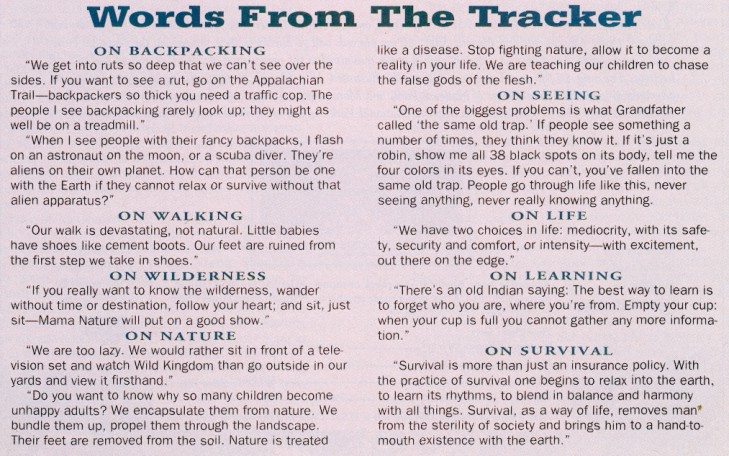
|
|
This website has no official or
informal connection to the Tracker School or Tom Brown Jr. whatsoever |
|
|
|
|

